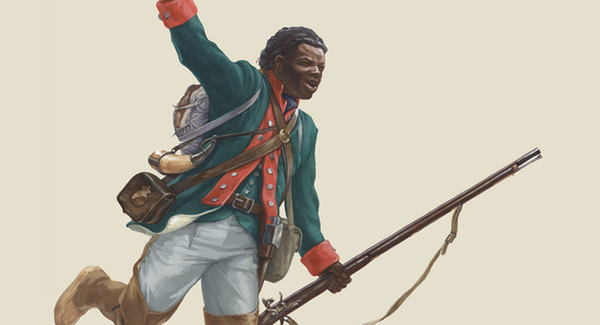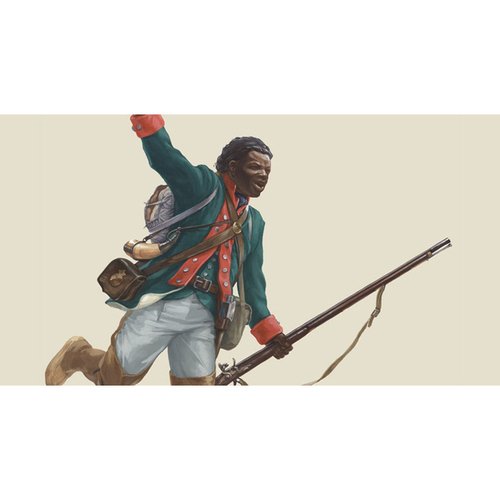
Source: Link
PIERPOINT (Parepoint, Pawpine), RICHARD, also known as Captain Dick and Black Dick, soldier, militiaman, labourer, and farmer; b. c. 1744 in Bondu (Senegal); d. before 27 Sept. 1838 near Fergus, Upper Canada.
Whether slaves or free men, blacks in early Upper Canada were obscured in the historical record by the persistence of slavery and by their lack of political clout, small numbers, and illiteracy. Occasionally the life of an individual is illuminated by an extraordinary event, such as a criminal act [see Jack York*], but for most blacks historical evidence is fragmentary. This is the case for Richard Pierpoint.
Pierpoint’s fascinating odyssey began in West Africa, where about 1760 he “was made a Prisoner and Sold as a Slave.” Shipped to the American colonies, he became the slave of a British officer. During the American revolution he took the opportunity offered to slaves of enlisting in the British forces and gaining their freedom. Although by 1779 it was rare for blacks to serve in the northern British armies, much less the loyalist provincial corps, Pierpoint was a pioneer in John Butler*’s rangers. By 1780 he was stationed with them in the Niagara region of Quebec. On 20 July 1784 his name appeared among those of disbanded rangers on a list of persons intending to settle in that area. Blacks were entitled to the same proportion of land as their fellow loyalists and about 1788 Pierpoint, under his more common name of Captain Dick or Black Dick, was granted 200 acres of land on Twelve Mile Creek, in what later became Grantham Township. He received his patents for the land on 10 March 1804, only to sell his lots on 11 Nov. 1806, one going to the dominant figure in the region, Robert Hamilton*.
On 29 June 1794 Pierpoint had been one of 19 signatories to a petition of “Free Negroes” to Lieutenant Governor John Graves Simcoe*. This brief document provides a rare glimpse into black settlement. The group consisted of veterans of the “late War,” and “others who were born free with a few who have come, into Canada since the peace.” Apparently landless and socially isolated for the most part, they were “desirous of settling adjacent to each other in order that they may be enabled to give assistance (in work) to those amongst them who may most want it.” They urged Simcoe “to allow them a Tract of Country to settle on, separate from the white settlers.” The petition was quickly scotched on 8 July by a committee of the Executive Council. Its minute-book suggests the petition’s emphasis on land separate from whites as the most likely explanation
Between 1806 and the War of 1812 Pierpoint probably resided in Grantham Township, earning his living as a labourer. War once again provided him with an opportunity for change and he “proposed to raise a Corps of Men of Colour on the Niagara Frontier.” His offer was turned down but a small black corps was raised locally by Robert Runchey in October 1812. The old ranger volunteered immediately, serving as a private from 1 Sept. 1812 to 24 March 1815. The Coloured or Black Corps, as it was sometimes called, varied between 27 and 30 men, excluding sergeants and officers. It saw action at the battle of Queenston Heights on 13 Oct. 1812 and was involved in heavy fighting during the siege of Fort George (Niagara-on-the-Lake) on 27 May 1813. The corps remained with Brigadier-General John Vincent’s army on the retreat west to the head of Burlington Bay (Hamilton Harbour) and then followed it east again after the battle of Stoney Creek on 6 June 1813. For the remainder of the war the blacks were used for labour or garrison duty, stationed either at Fort Mississauga (Niagara-on-the-Lake) or Fort George and possibly seeing action at Lundy’s Lane on 25 July 1814. When the corps was disbanded in 1815 Pierpoint returned to the life of a labourer in the Grantham area.
On 21 July 1821 Pierpoint, then a resident of Niagara (Niagara-on-the-Lake), petitioned Lieutenant Governor Sir Peregrine Maitland* for aid since he was finding it “difficult to obtain a livelihood by his labor” and was “above all things desirous to return to his native country.” His wish to return to the West African settlement he had left in the hold of a slave-ship some 60 years earlier was not realized. Instead the old soldier received a location ticket for 100 acres of land in unsettled Garafraxa Township on the Grand River, near present-day Fergus. Most of the grants here were to military claimants, including two other members of the Coloured Corps, Robert Jupiter and John Vanpatten. Of the three, only the aged Pierpoint took up his land, becoming one of the area’s earliest settlers. In May 1825 he completed the settlement duties clearing and fencing five acres and erecting a house.
On 28 Jan. 1828 Captain Dick made out his will, witnessed by sons of two former officers in Butler’s Rangers. The lone black in a settlement of whites, he had “no heirs nor relations.” He left his farm and a claim to one of his former lots in Grantham to a resident of Halton County, Lemuel Brown. Unfortunately Pierpoint had given the wrong concession number for the Grantham property and the Surveyor General’s Office reported the claim unsubstantiated. Pierpoint’s will was proved on 27 Sept. 1838. He had probably died that year or in late 1837 – an old African brought by the slave trade to the frontier of settlement in a land he never took for his own.
AO, RG 1, A-I–2, 30: 427; C-1-3, 132: 76; C-IV, Garafraxa Township, concession 1; Grantham Township, concession 6, lots 13–14; concession 8, lot 13; RG 22, ser.235, will of Richard Pawpine, 1838. BL, Add. mss 21828: 38 (copy at PAC). Niagara North Land Registry Office (St Catharines, Ont.), Abstract index to deeds, Grantham Township, 1: ff.87, 131 (mfm. at AO). PAC, MG 9, D4, 9: 187 (transcript); RG 1, L1, 19: 195; L3, 196: F misc., 1788–95/68; L7, 52a; RG 5, A1: 26441–44; RG 8, I (C ser.), 688E: 113, 115; 1701: 208. St Catharines Public Library, Corps of Colour, nominal return, 15 March 1819. Wellington South Land Registry Office (Guelph, Ont.), Abstract index to deeds, West Garafraxa Township, 5 (mfm. at AO). “District of Nassau: minutes and correspondence of the land board,” AO Report, 1905: 340. Doc. hist. of campaign upon Niagara frontier (Cruikshank), 1: 51; 4: 161, 170; 5: 221, 271; 6: 73, 331; 7: 51. “Settlements and surveys,” PAC Report, 1891, note A: 4. St. Catharines Journal, 24 May, 12 June 1856. The centennial of the settlement of Upper Canada by United Empire Loyalists, 1784–1884 . . . (Toronto, 1885). G. E. French, Men of colour: an historical account of the black settlement on Wilberforce Street and in Oro Township, Simcoe County, Ontario, 1819–1949 (Stroud, Ont., 1978). J. N. Jackson, St. Catharines, Ontario; its early years (Belleville, Ont., 1976). Benjamin Quarles, The negro in the American revolution (Chapel Hill, N.C., 1961). E. [A.] Cruikshank, “The battle of Fort George,” Niagara Hist. Soc., [Pub.], no12 (1904): 21, 29, 34. W. R. Riddell, “Some references to negroes in Upper Canada,” OH, 19 (1922): 144–46.
Cite This Article
Robert L. Fraser, “PIERPOINT (Parepoint, Pawpine), RICHARD (Captain Dick, Black Dick),” in Dictionary of Canadian Biography, vol. 7, University of Toronto/Université Laval, 2003–, accessed January 5, 2026, https://www.biographi.ca/en/bio/pierpoint_richard_7E.html.
The citation above shows the format for footnotes and endnotes according to the Chicago manual of style (16th edition). Information to be used in other citation formats:
| Permalink: | https://www.biographi.ca/en/bio/pierpoint_richard_7E.html |
| Author of Article: | Robert L. Fraser |
| Title of Article: | PIERPOINT (Parepoint, Pawpine), RICHARD (Captain Dick, Black Dick) |
| Publication Name: | Dictionary of Canadian Biography, vol. 7 |
| Publisher: | University of Toronto/Université Laval |
| Year of publication: | 1988 |
| Year of revision: | 1988 |
| Access Date: | January 5, 2026 |



